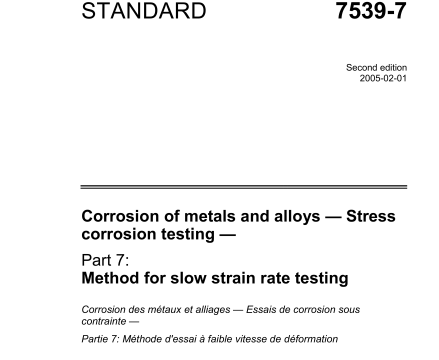ISO 7539-7 pdf download – Corrosion of metals and alloys -Stresscorrosion testing— Part 7: Method for slow strain rate testing.
6.3 For initially plain specriens, especially with a waisted gauge length, the strain rate at the outset of the test s readily defined, but once cracks are initiated and have grown to some extent in such specimens, straining is likely to be concentrated in the material in the vicinity of the crack tip and may not be the same as the initial strain rate, Rigorous solutions for the strain rate at notches are not yet available, but it is likely that the effective strain rates will be higher than those for the same displacement rates applied to plain specimens
6.4 Tests may involve taking a specimen to total failure, and assessing the mode of failure in order to determine susceptibility to stress corrosion cracking, or stopping a test at some intermediate stage and then determining the extent of crack initiation or growth.
6.5 Experience suggests that for initially plain specimens tested in tension, a strain rate in the region of
1O s’ is appropriate for the initial test. The absence of stress corrosion cracking from such a test is not necessarily indicative of immunity from stress corrosion cracking in the system studied, since susceptibility is known to be a function of, amongst other parameters, strain rate (see Annex A). Subsequent tests at other strain rates, such as iO s and iO s, should be conducted if the initial test produces no evidence of stress corrosion cracking.
6.6 The environmental testing conditions selected depend upon the purpose of the test but ideally, should be the same as those prevailing for the intended use of the metal or comparable to the anticipated service condition. In practice, a number of standard environments is used for ranking purposes, but application of the results obtained for predicting service behaviour depends on an understanding of the system or on correlation with experience.
6.7 Environmental factors of importance are electrode potential, temperature, solution composition. pH. concentration of dissolved gases, flow rate and pressure ISO 7539-1 provides useful background information. In relation to gaseous environments a critical factor is purity of the gas.
6.8 Tests may be conducted under open circuit conditions in which the electrode potential of the metal is dependent on the specific environmental conditions of the test, of which the degree of aeration is an important factor. Alternatively, the electrode potential may be displaced from the open circuit value by potentiostatic or galvanostatic methods,
6.9 AuxilIary electrodes to apply extemal cwrent should be designed to produce uniform current distribution on the specimen. i e. the electrode potential should be constant,
6.10 The establishment of cracking conditions in a given metal!environment combination may be time- dependent, if they do not exist at the outset of the test. In such circumstances stress corrosion cracking may only be observed if the strain rate is sufficiently slow to ensure that overload failure does not occur before the necessary time has elapsed whereby the necessary environmental conditions for aacklng have been established. These difficulties can sometres be avoided by exposure of the specrens to the test environment for some time prior to the initiation of dynamic strain.
6.11 It is recommended that wherever possible the gripped portions be exduded from contact with the corrosive environment. If this is not possible, the problems that may arise Niclude the following:
a) galvanic effects will almost invariably influence results if the grips are made from a material different from that of the test piece and electncal insulation is then necessary:
b) crevice corrosion may occur within the confines of the restricted spaces between grips and test pieces and stress discontinulties can lead to premature stress corrosion failure In such regions;
c) crevice problems may arise also where the test piece emerges from the test cell and these should be avoided by appropriate design of the cell, by the use of protective coatings at such positions or by enlargement of the cross-sectional area of the test piece beyond the parallel portion.
ISO 7539-7 pdf download – Corrosion of metals and alloys -Stresscorrosion testing— Part 7: Method for slow strain rate testing
